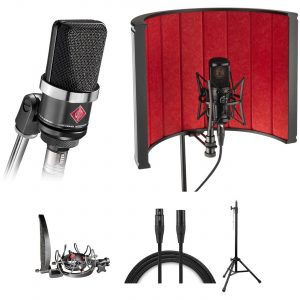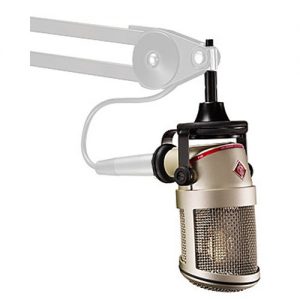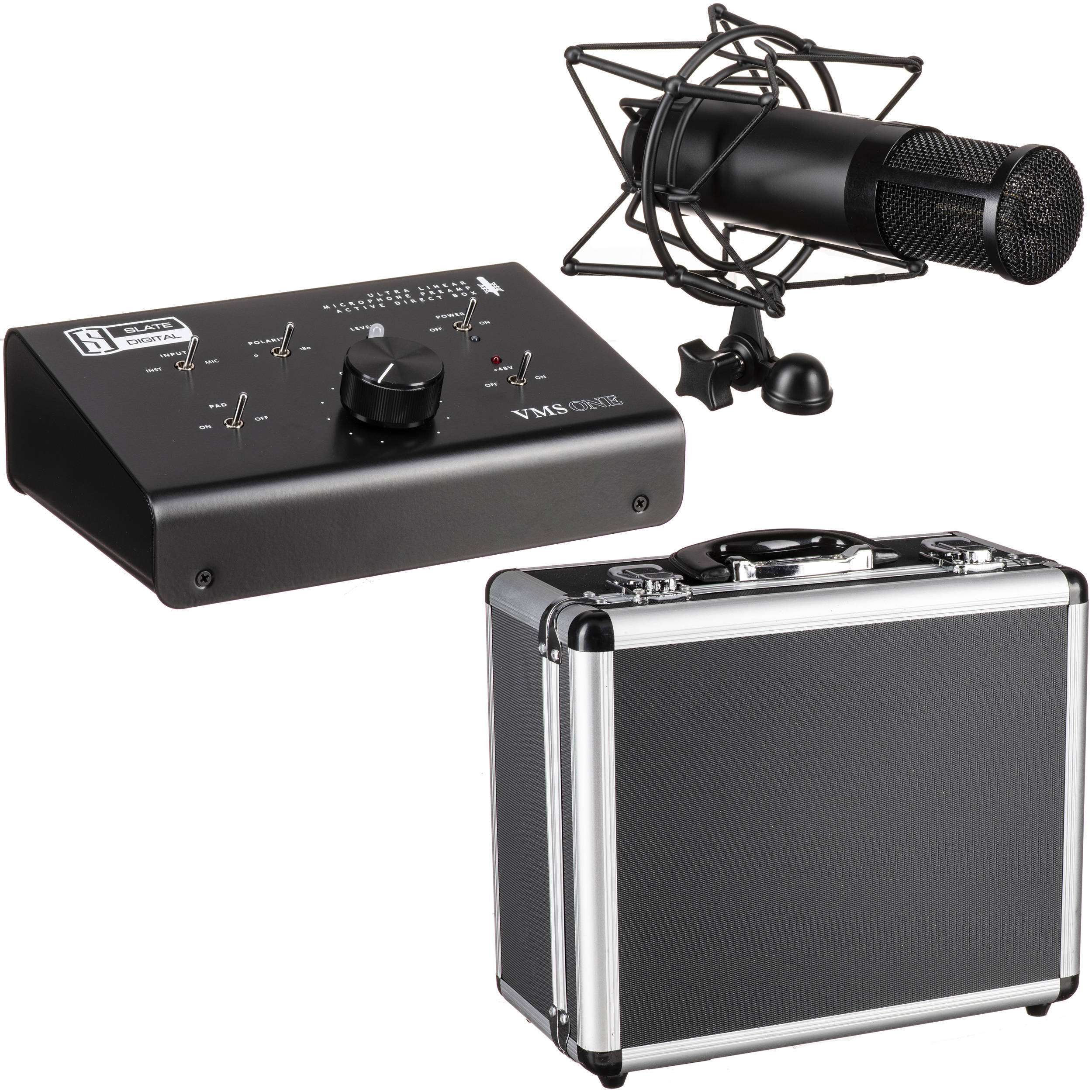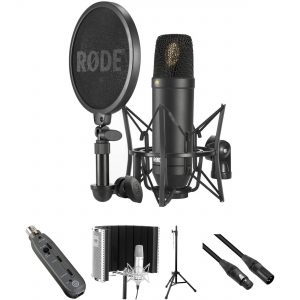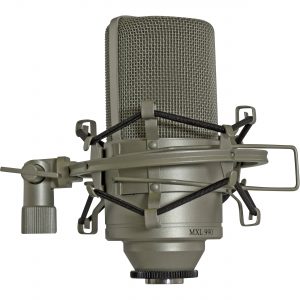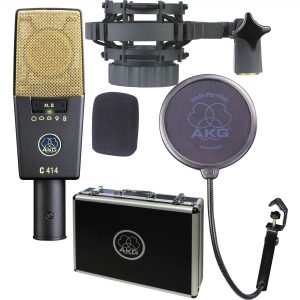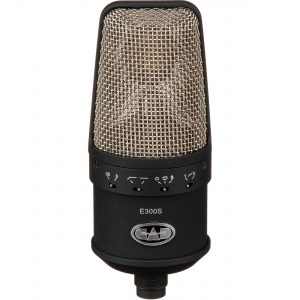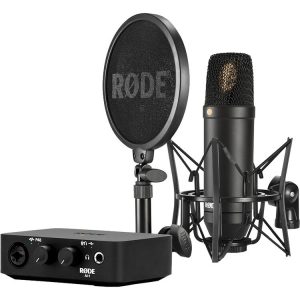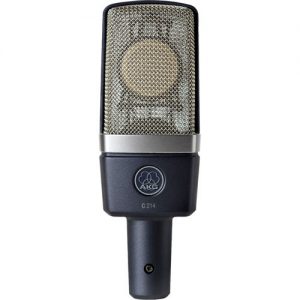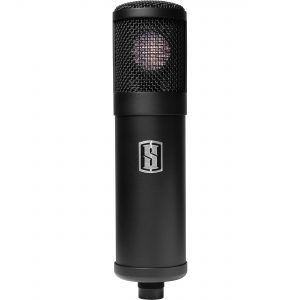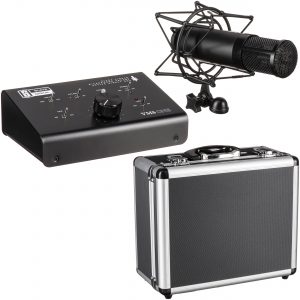Virtual Microphone System Shoot Out At NRG StudiosSlate Digital VIRTUAL MICROPHONE SYSTEM: The Future of MicrophonesBundled together for your convenience, the Slate Digital VMS Kit includes the VMS ONE Preamp and an ML-1 Large-Diaphragm Condenser Modeling Microphone. With these two items, you’ll be able to faithfully model and record the sound of classic microphones and preamps.
The microphone, which boasts a frequency response of 20 Hz to 20 kHz, allows you to emulate both dynamic microphones and LDCs, doing so with minimal distortion for transparency in the emulation process. The preamp, on the other hand, was designed by famed gear guru Paul Wolff, who designed classic gear for API; it too provides a transparent operation, giving you 57 dB of gain, a Neutrik combination XLR-1/4″ input, and controls for polarity, phantom power, and more.
The VMS Kit comes with a perpetual license for the Virtual Preamp Collection, which offers emulations of classic gear pieces that can serve you well in the recording and mixing process.Slate Digital ML-1 Large-Diaphragm Modeling Microphone (Black)The Slate Digital ML-1 is a large-diaphragm condenser microphone that is meant to be used with the VMS (Virtual Microphone System) or the VRS (Virtual Recording Studio). The microphone captures a linear frequency response between 20 Hz to 20 kHz, doing so with minimal distortion. In this way, it can serve as the unpainted canvas on which you’d apply the digital color of Slate’s microphone emulations. Indeed, paired with the VRS or VMS, the microphone aims to put heretofore cost-prohibitive, holy-grail mic/pre combinations at your fingertips.
Included with the ML-1 is a bundle of emulations of prized microphones often used on vocals. Models of the U47, U67, SM7, 251, and other famous microphones are included with your purchase. For preamps, Slate offers software versions of the classic British 73 preamp, and the German 76.?
Here, the microphone is offered a la carte. It is recommended you pair the ML-1 with Slate’s complementary preamps or interfaces, so that the emulations work to the best of their ability. If you prefer, you can use the mic with your existing preamp or interface, but the results may not be the same.Low Latency OperationNone of the processing included with this microphone should add latency to the audio signal, so if you use a low latency interface with the microphone, you can track through the VMS software without any audible monitoring delay. This low-latency operation can be achieved through Thunderbolt or high-speed USB, recording at 96 kHz with the lowest possible buffer size.Mac and Windows CompatibleThe software works with Mac and Windows systems. For Mac, it’s recommended you’re running OS X 10.9 or later. For Windows, you’ll need Windows 7 and above. A second- or third-generation iLok is required. VST2, VST3, AU, and AAX formats are all supported.Overview of Mic Models IncludedMore mic models are released sporadically, but at the very least, you get the following:FG-47: This mic model recreates a venerated vintage tube microphone with a thick, full-bodied low end, rich and present midrange, and a smooth top end. This mic works well on lead vocals, kick drums, drum kits overall, guitars, horns, and strings.FG-M7: A combination of a dynamic microphone made famous by Michael Jackson and the tube stage of a classic 47, this model offers a punchy, crisp sound with a cutting midrange.?FG-800: This is a recreation of a popular modern tube microphone, used often on hip hop and pop vocals. It¡¯s quite airy and bright, though the bottom-end is warm, resulting in a timbre that sounds polished right from the source. In addition to vocals, this model shines on acoustic guitars and drum overheads.?FG-251: This model recreates a well-regarded vintage tube microphone with a crisp, yet warm sound. In addition to vocals, try this model on electric guitars, acoustic guitars, drums, and more.?FG-800M: Slightly darker and fatter than the FG-800, this model captures the feeling of an older model with a Japanese tube stage. Use this when you like the sound of the FG-800, but want to mitigate brightness and sibilance.?FG-67: This model emulates a classic 67 microphone, giving you the dark, bold, and thick sound that mic often delivers. Vocals, pianos, and horns can all benefit from the FG-67, or you can use it as your room mic model for drum kits.?FG-269: This emulation captures a mic with the same circuit as the 67, but with a different tube stage. The result is an open and clear sound in the same German style of the 67 and 47 models.?FG-12: Taking its cues from a classic Austrian microphone, this model delivers both a rich and smooth sound.Preamps OfferedFG-73: The FG-73 preamp module is modeled after one of the most famous discrete solid-state preamps in the industry, made in Britain and used on countless recordings. It has a bold, present, and warm sound that works great on any audio source, including full mixes.FG-76: The FG-76 preamp module is modeled after a vintage German tube preamp that has been used on many classic recordings. It has a thick and colorful tone that can make tracks and mixes sound more lively. The bottom end saturates in a musical way, making it a great module for bass guitar and kick drum tracks.Slate Digital VMS ONE Single-Channel PreampFor those who wish to use Slate Digital’s modeling microphone systems with their own converters, Slate Digital offers the VMS ONE here. This is a single-channel preamp designed by Paul Wolff, whose name is well-regarded in pro-audio circles.
The VMS ONE features an XLR-1/4″ combination jack from Neutrik that will accommodate both balanced XLR and unbalanced 1/4″ inputs. Two output jacks are provided, one XLR connection and one 1/4″, and it’s best to use either one or the other at any one time.
With the +48V phantom power switch, you can power the ML-1 or ML-2 microphones that work best with the unit, though it’ll also serve as a linear, transparent preamp for all sorts of microphones. A pad switch is provided to give you a fixed attenuation of -20 dB before the first stage of the input amplifier, so you can use microphones with loud sources. Other controls include an input selector switch, a polarity switch, and a prominent gain knob. The preamp is capable of 57 dB of gain.
The preamp is offered a la carte here. It’s designed to be utilized with the ML-1 or ML-2 modeling microphone from Slate. Along with these mics and the corresponding modeling software, this item comprises one aspect of Slate’s Virtual Microphone System.
Slate Digital ML-1 Large-Diaphragm Modeling Microphone (Black) SpecsSound FieldMonoCapsuleCondenserDiaphragm1.10″ / 28?mm (Condenser)Polar PatternCardioidCircuitrySolid-StateFrequency Range20 Hz to 20 kHz ImpedanceCardioid: 200 OhmsLoad Impedance10 KilohmsSensitivityCardioid: 20 mV/PaSignal-to-Noise RatioCardioid: 77 dB A-WeightedEquivalent Noise LevelCardioid: 17 dB A-WeightedOutput Connectors1 x 3-Pin XLROperating Voltage48 VLength8.47″ / 215.2?mmDiameter2.13″ / 54?mmWeight1.28?lb / 582?gPackaging InfoPackage Weight5.835 lbBox Dimensions (LxWxH)12.4 x 11.65 x 6.45″Slate Digital VMS ONE Single-Channel Preamp SpecsMaximum Gain57 dBMaximum Input Level-2 dBu (without pad), +18 dBu (with pad)Maximum Output+27 dBuGain Range-30 to +27 dBNoise< -100 dBu, (-30 in adjusted to +4 dB out)ControlsInstrument/mic switch Polarity switch Power switch Pad switch Gain knob 48V phantom power switchPower Connector5-Pin XLR connectionSystem Requirements (Mac)Mac OS X 10.7 or later (32-/64-bit) Mac Quad Core i5 Intel Processor 4 GB RAM iLok 2 or 3System Requirements (Windows)Windows 7 or later (32-/64-bit) Mac Quad Core i5 4 GB RAM iLok 2 or 3Supported Plug-In FormatsVST2, VST3, AU, XS
